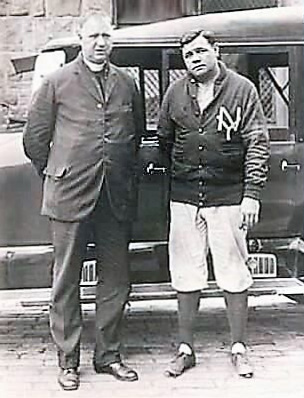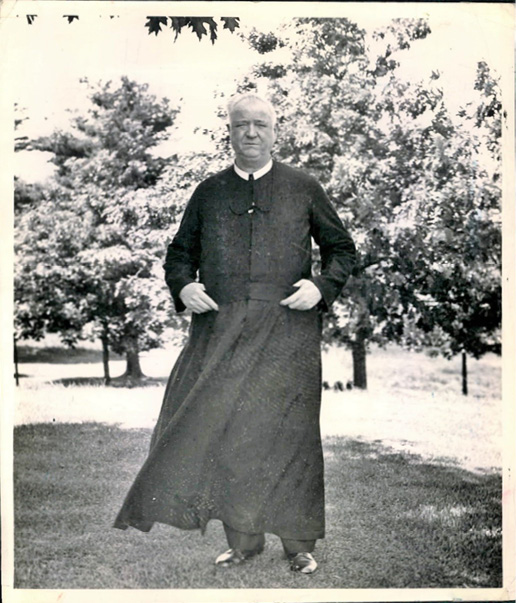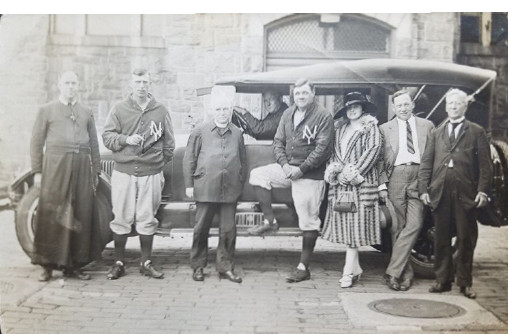Babe Ruth: Brother Matthias To the Rescue
This article was written by Chip Martin
This article was published in The Babe (2019)
During the 1926 season, Babe Ruth played 152 games and launched 47 home runs, while batting .372. He continued to be a headache for general manager Ed Barrow and his diminutive on-field manager Miller Huggins, with whom he clashed about his behavior on and off the field. The Yankees continued to hire private detectives to keep an eye on their star, especially when they were on the road. Late in the 1925 season, a detective reported Ruth was with six different women in Chicago and had patronized the most famous whorehouse in St. Louis.1 Exasperated, Huggins suspended Babe and fined him $5,000.
From time to time, the Yankees called upon Brother Matthias of St. Mary’s to provide fatherly advice to which Babe seemed to respond positively. In June 1926, on their first trip to Chicago, a city whose delights invariably led Babe astray, the Yankees stayed at the Del Prado Hotel and decided once again to call upon Brother Matthias. Their four-game series began June 17 and the city was hopping. The 28th International Eucharistic Congress was being held from June 20 to 24 and the Yankees invited Matthias to attend the event, covering expenses, and hoped he would counsel his former student while he was in town. The Congress, a sort of spiritual Olympics for Catholics, was expected to attract nearly a million attendees for its first time held in the United States. One of the featured events was a pontifical high mass at Soldiers’ Field that attracted half a million adherents of the faith.2
One evening, Matthias came to the Del Prado and occupied a chair in the lobby from which he could see the hotel elevator. Ruth soon appeared, with plans for another night on the town, but when he spotted Matthias the two greeted each other warmly. Matthias explained he happened to be in the Windy City for the Congress, but also wanted to see Ruth play. So he learned where the Yankees were staying and wanted to take his former pupil out to dinner. Ruth promptly altered his plans for the night and stayed out with Matthias until nearly 11 p.m.
During their meal, Matthias delivered strong advice to Ruth about his need to clean up his act. It can be easily surmised he told Ruth he was disappointed in what he had been hearing about his off-field activities, the women, the parties, the pursuit of pleasure. Matthias said he hadn’t encouraged young Ruth to live a God-centered life only to see him pursue such a hedonistic lifestyle. The boys at St. Mary’s worshipped him and they deserved a hero whose behavior they could model. Babe was letting them down. Matthias also suggested Ruth should try to rebuild his relationship with his wife Helen. The papers had been full of stories about his marital woes, but Matthias said divorce was out of the question. The prodigal son listened intently and promised to do better. As Ruth biographer Marshall Smelser put it, “this was the turning point in Ruth’s behavior. Certainly he no longer after that time had the reputation for hell-raising that he had before.”3 There would still be lapses. After all, he was Babe Ruth.
There were other times when Matthias lent an ear to the man he addressed only as “George.” Babe leaned on him during times of crisis, most notably during his dreadful 1925 season. That year, the Home Run King was hospitalized by a mystery ailment dubbed “The Bellyache Heard Around the World,” and later clashed with manager Miller Huggins. At the same time, Ruth’s marriage to Helen was in shambles and the newspapers were full of speculation his best days were behind him. Matthias sensed his former pupil needed help. He called Ruth several times from St. Mary’s during his darkest hours, offering advice and support and asking if he could somehow help save the troubled marriage.4
Matthias, Ruth’s surrogate father, always brought him back to earth and the superstar mended his ways, if only for a time. His deep and abiding respect for Matthias saw him purchase his mentor a shiny new Cadillac as a thank-you after one of their “Come to Jesus” sessions. This was in 1922, 1925, or 1926, depending on the source. Biographer Marshall Smelser said the gift came after Babe received one of his first big pay checks from the Yankees in 1922. That date seems to be confirmed by the Baltimore Sun which reported in early 1923 that Matthias drove some theatrical performers to St. Joseph’s Monastery in the Baltimore suburb of Irvington “in an automobile given the latter by ‘Babe’ Ruth, the baseball player.”5
Brother Matthias, who mentored Ruth at the St. Mary’s Industrial School for Boys in Baltimore. (Courtesy of David McDonald.)
Biographer Kal Wagenheim said the extravagant gift was bestowed on Matthias during Babe’s dismal 1925 season when he seemed to hit rock bottom as an overweight, ill, and suspended troublemaker. Matthias had called him repeatedly during the crisis, offering his counsel, but Babe wanted to see him in person and invited Matthias to New York. There, the two men engaged in heart-to-heart discussion as they strolled the streets of the city. Babe loved shiny new cars and when he spotted a Cadillac in a Manhattan showroom he was distracted, and asked his towering mentor: “Do you think I ought to buy that car?” Matthias replied: “If you can afford it, George.” Matthias couldn’t believe his eyes the next day when the Cadillac was delivered to his hotel, with a note thanking him “for what you and St. Mary’s have done for me.”6
The gift put Matthias in a quandary. When he became a Xaverian Brother, he made a vow of poverty and couldn’t own worldly possessions. So the vehicle was registered to the school but Matthias had priority use of it and ferried students to various destinations. In return, they helped him clean and maintain it, learning the basics of auto mechanics. Ever the teacher, Matthias turned his gift into a teaching tool. Ruth biographer Jane Leavy said Ruth bought Matthias a second Cadillac in 1926, shortly after the Chicago visit, but doesn’t indicate when the first was given him.7
With a recharged and refocused Ruth in their lineup for 1926 and some talented new players, the Yankees claimed the American League pennant but lost the World Series to St. Louis. Babe and his bat were back. But the greatest season for the Yankees and their slugger still lay ahead.
BRIAN “CHIP” MARTIN is a retired journalist from London, Ontario. He is a member of SABR, member of selection committee for Canadian Baseball Hall of Fame, and founding director of Centre For Canadian Baseball Research, as well as the author of eight books to date, which will include the forthcoming The Man Who Made Babe Ruth: Brother Matthias of St. Mary’s School (McFarland & Co., 2020.)
Sources
Research for this article came during preparation of the author’s book The Man Who Made Babe Ruth: Brother Matthias of St. Mary’s School, published by McFarland in 2020.
Notes
1 Leigh Montville, The Big Bam: The Life and Times of Babe Ruth (New York: Anchor Books, 2006), 207.
2 “Program of the Congress,” Chicago Tribune, June 14, 1926, 17.
3 Marshall Smelser, The Life that Ruth Built (Lincoln: University of Nebraska Press, 1975), 332-333.
4 Kal Wagenheim, Babe Ruth: His Life and Legend (Chicago: Olmstead Press, 2001), 147.
5 “White House Talk Explained by Lang,” Baltimore Sun, March 17, 1924: 4.
6 Joe Winkworth, “I’ve Been the Sappiest of Saps — Ruth,” The Sporting News, November 5, 1925: 2.
7 Jane Leavy, The Big Fella: Babe Ruth and the World He Created (New York: HarperCollins, 2018), 162.





